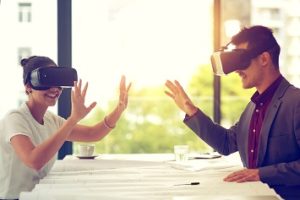Older generations warned that sitting too close to the television would give you cancer; for younger whippersnappers, the warning has been updated to talking on their cell phones. The evidence is still inconclusive on that, but it seems pretty strong for “BlackBerry thumb”—a repetitive stress injury caused by too much texting—and “laptop back”—neck and shoulder pain caused by hunching over a laptop computer.

PeopleImages / E+ / Getty Images
But maybe you haven’t yet heard of the latest gadget-y health issue—let’s just call it, “Apple eye.”
New Gadgets, New Injuries?
A murmur ran through the tech world in April when a workplace health and safety report from Apple was leaked to tech site Gizmodo. For techie types, the excitement was that Apple appears to be working on an eye-mounted prototype device of some kind. But what caught the eye of health and safety types was the fact that the report documented eye injuries suffered by two Apple employees who were testing the device. It seems the devices are augmenting reality using lasers—which were not adequately shielded, leading to eye pain.
It’s not the first hazard attributable to the world of new gadgets, especially “augmented reality” or “virtual reality” (VR) devices. Previous experiences with Google Glass®, Samsung’s Gear VR, and similar devices have led to reports of:
- Seizures. Epileptics often need to be careful of flashing screens; augmented reality devices are believed to carry a seizure risk. Users should be aware of the risk of dizziness, seizures, and blackouts.
- Nausea or motion sickness. Sometimes called “cybersickness” or “sim-sickness,” VR devices give some sensory input, but it’s not consistent with other sensory input from the body. For some, the inconsistency is literally nauseating. Highly sensitive souls often have trouble even with 3-D movies.
- Eye strain. As with any electronic device, prolonged use of VR headsets can lead to eyestrain and dry eyes.
- Loss of awareness and disorientation. When Google Glass was first made commercially available, there were reports of people walking into traffic and falling into holes they did not see. VR gaming headsets have reportedly led to people taking swings in the virtual world that connected with people and objects in the real world.
- Problems with balance, hand–eye coordination, and depth perception. For the same reason the devices induce motion sickness—inconsistent sensory input—they can also induce balance, vision, and coordination problems.
- Drowsiness. People who use a VR device may become drowsy enough to make driving or operating heavy machinery dangerous for several hours afterward.
- Delayed effects. The health and safety guide for the Oculus Rift® VR headset notes that symptoms can become more pronounced hours after the VR headset is removed—rather like the delayed symptoms people experience when they disembark a cruise ship.
- Tripping and entanglement hazards. Corded systems pose a tripping and entanglement hazard for both the user and anyone else nearby.
Of course, all of this is gaming and entertainment-related, right? It will surely have very little bearing on the workplace. Or will it? VR may create some hazards, but as you’ll see, it also helps prevent hazardous exposures.
VR at Work
VR technology is already being used to make the workplace safer and more efficient.
Playground of the mind. Many larger manufacturers, including Boeing, Raytheon, and Renault, are using VR in the design and assembly parts of their processes. VR “caves,” rooms, or even screens show highly detailed, immersive simulations of products during the development stage. During development, the simulations allow designers to test new concepts and collaborate with each other from anywhere in the world.
Training ground. When “live” training would be expensive or hazardous, VR training enables workers to practice skills and experience consequences without harm to personnel—or to expensive equipment! Flight simulators were, perhaps, the original VR environment, but many other employers are using VR to create realistic training environments. For example, electricians, miners, and firefighters can all train in VR simulators rather than risk electrocution, falls off a roof, or fires. Rescue crews can practice high-angle rescues from the safety of the ground, and brain surgeons can practice tricky surgeries without cutting into an actual patient.
VR can also allow workers in some fields to experience interactions through their customer’s or client’s eyes. Doctors can pass through the system as patients; nursing personnel can experience firsthand the effects of dementia.
Sales tool. VR is already in use as a sales tool in many industries. Real estate agents can provide “virtual” tours, as can hotel operators. Car salesmen can let customers take a virtual “test drive”; home improvement stores can show customers exactly what their new kitchens will look like; and college campuses can offer far-away prospective students a virtual tour.
Virtually Risk-Free
As VR technology becomes more widespread and useful, it’s important to protect workers’ health and safety. Here are some tips for keeping your VR environment virtually risk-free:
- Take breaks. Musculoskeletal disorders are a potential drawback of almost any device, and VR is no different. Workers should periodically get up, walk around, and stretch. Dry eyes and eye strain can also be a problem. To prevent these health issues, workers should take 10–15 minutes breaks every 30 minutes, whether they think they need to or not.
- Clear the room. If workers will be using devices that obstruct their vision, take precautions to make sure there are no other people nearby who could be hurt and that there are no tripping hazards, burn hazards, or similar dangers in the work area.
- Don’t drive. Because VR devices can cause motion sickness, disorientation, drowsiness, dizziness, and problems with depth perception and hand-eye coordination, workers should not drive until their heads are clear and their hands are steady.
